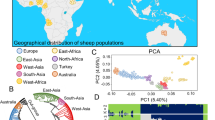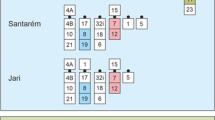Abstract
Within Australia, the gekkonid lizard Heteronotia binoei exists as diploid bisexual and triploid all-female populations. Three bisexual cytotypes and three triploid clones can be described on the basis of the morphology of gross karyotypes. This paper reports the results of a C-banding analysis that revealed both intrapopulation polymorphism and interpopulation polytypic variation within the most widespread bisexual cytotype (A6). A C-band variant that defined a ZW sex chromosome system in populations from the MacDonnell Ranges in central Australia was also identified. Silver staining confirmed that in all populations the nucleolus organising region always occurred distally on chromosome 6. Examination of C-banding and silver-staining patterns of triploid populations provided strong support for a hybrid origin of the parthenogens that involved the central and western A6 populations. It is proposed that the hybridisation of these populations with the other chromosomally distinct bisexual cytotypes (SM6) resulted in the triploid clones. At present, seven clones have been karyotypically defined, and all the chromosomal variants that were present in the triploids can be accounted for by multiple hybridisation events between the bisexual populations. The analysis also provided evidence that rare sterile tetraploid females are the result of insemination of the triploid parthenogens by male H. binoei.
Similar content being viewed by others
References
Bell G (1982) The masterpiece of nature. Croom Helm, London and Canberra, p 635
Bickham JW (1983) Patterns and modes of chromosomal evolution in reptiles. In: Sharma AK, Sharma A (eds) Chromosomes in evolution of eukaryotic groups. CRC Press Inc., Boca Raton, in press
Bogart JP (1980) Evolutionary implications of polyploidy in amphibians and reptiles. In: Lewis WH (ed) Polyploidy: Biological relevance. Plenum Press, New York and London, pp 341–378
Chevalier M, Dufaure JP, Lecher P (1979) Cytogenetic study of several species of Lacerta (Lacertidae, Reptilia) with particular reference to sex chromosomes. Genetica 50:11–18
Cimino MC (1972) Meiosis in a triploid all-female fish (Poeciliopsis, Poeciliidae). Science 175:1484–1486
Cole CJ (1978) Parthenogenetic lizards. Science 201:1154
Cuellar O (1971) Reproduction and the mechanism of meiotic restitution in the parthenogenetic lizard, Cnemidophorus uniparens. J Morphol 133:139–166
Cuellar O (1974) On the origin of parthenogenesis in vertebrates: the cytogenetic factors. Am Nat 108:625–648
Cuellar O (1976) Cytology of meiosis in the triploid gynogenetic salamander Ambystoma tremblayi. Chromosoma 58:355–364
Cuellar O (1978) Parthenogenetic lizards. Science 201:1155
Darevsky IS, Kupriyanova LA, Bakradze MA (1978) Occasional males and intersexes in parthenogenetic species of Caucasian rock lizards (genus Lacerta). Copeia 1978:201–207
John B, Lewis KR (1968) The chromosome complement. Protoplasmatologia 6A, Springer, Wien
King M (1977) The evolution of sex chromosomes in lizards. In: Evolution and reproduction. Proc. 4th Int Conf Reprod Evol. Aust Acad Sci Canberra, pp 55–60
King M (1980) C-banding studies on Australian hylid frogs: secondary constriction structure and the concept of euchromatin transformation. Chromosoma 80:191–217
King M (1982) Chromosome change and speciation in lizards. In: Atchley WR, Woodruff DS (eds) Evolution and speciation. Cambridge Univ Press, Cambridge, pp 262–285
King M, Rofe R (1976) Karyotypic variation in the Australian gekko Phyllodactylus marmoratus (Gray) (Gekkonidae: Reptilia). Chromosoma 54:75–87
Kobel HR, Du Pasquier L (1975) Production of large clones of histocompatible fully identical clawed toads (Xenopus). Immunogenetics 2:87–91
Macgregor HC, Uzzell TM (1964) Gynogenesis in salamanders related to Ambystoma jeffersonium. Science 143:1043–1045
Martin J, Kuvangkadilok C, Peart DH, Lee BTO (1981) Multiple sex determining regions in a group of related Chironomus species (Diptera: Chironomidae). Heredity 44:367–382
Mengden GA (1981) Linear differentiation of the C-band pattern of the W chromosome in snakes and birds. Chromosoma 83:275–287
Moran C (1981) Spermatogenesis in natural and experimental hybrids between chromosomally differentiated taxa of Caledia captiva. Chromosoma 81:579–591
Moritz C (1983) Parthenogenesis in the endemic Australian lizard, Heteronotia binoei (Gekkonidae). Science 220:735–737
Muller WP (1977) Diplotene chromosomes of Xenopus hybrid oocytes. Chromosoma 59:273–282
Olert J (1979) Interphase studies with a simplified method of silver staining of nucleoli. Experientia 35:283–285
Parker Jr ED (1979) Ecological implications of clonal diversity in parthenogenetic morphospecies. Am Zool 19:753–762
Peccinini-Seale D (1981) New developments in vertebrate cytotaxonomy. IV. Cytogenetic studies in reptiles. Genetica 56:123–148
Post RJ (1982) Sex-linked inversions in blackflies (Diptera: Simulidae). Heredity 48:85–93
Rothfels KH, Nambiar R (1981) A cytological study of natural hybrids between Proimulium multidentatum and P. magnum. Chromosoma 82:673–691
Sessions SK (1982) Cytogenetics of diploid and triploid salamanders of the Ambystoma jeffersonium complex. Chromosoma 84:599–621
Shaw DD, Wilkinson P (1978) “Homologies” between non-homologous chromosomes in the grasshopper Caledia captiva. Chromosoma 68:241–259
Shaw DD, Coates D, Wilkinson P (1983) Increased chromosome mutation rate following hybridisation between two subspecies of grasshoppers. Science 220:1165–1167
Thompson RC (1980) Cytogenetical and population studies of B-chromosomes in Rattus fuscipes (Rodentia: Muridae). MSc thesis, LaTrobe University, Melbourne, Australia
Uzzell T (1970) Meiotic mechanism of naturally occurring unisexual vertebrates. Am Nat 104:433–455
Uzzell TM, Goldblatt SM (1967) Serum proteins of salamanders of the Ambystoma jeffersonium complex and the origin of triploid species of this group. Evolution 21:345–354
Webb GC, White MJD, Contreras N, Cheney J (1978) Cytogenetics of the parthenogenetic grasshopper Warramaba (formerly Moraba) virgo and its bisexual relatives. Chromosoma 67:309–339
White MJD (1973) Animal cytology and evolution. Cambridge Univ Press, London, New York, Melbourne, p 958
White MJD (1975) Chromosome repatterning — regulations and restrictions. Genetics 79:63–72
White MJD (1978) Modes of specication. W.H. Freeman & Co., San Francisco, p 455
White MJD, Contreras N (1982) Cytogenetics of the parthogenetic grasshopper Warramaba virgo and its bisexual relatives VIII. Karyotypes and C-banding patterns in the clones of W. virgo. Cytogenet. Cell Genet 34:168–177
Wright JW (1973) Evolution of the X1Y2Y sex chromosome mechanism in the scincid lizard Scincella laterale (Say.). Chromosoma 43:101–108
Wright JW (1978) Parthenogenetic lizards. Science 201:1152r1154
Wright JW, Lowe CH (1968) Weeds, polyploids, parthenogenesis and the geographical and ecological distribution of all-female species of Cnemidophorus. Copeia 1968:128–138
Author information
Authors and Affiliations
Additional information
This paper is dedicated to the memory of M.J.D. White (1910–1983)
Rights and permissions
About this article
Cite this article
Moritz, C. The origin and evolution of parthenogenesis in Heteronotia binoei (Gekkonidae). Chromosoma 89, 151–162 (1984). https://doi.org/10.1007/BF00292899
Received:
Revised:
Issue Date:
DOI: https://doi.org/10.1007/BF00292899




